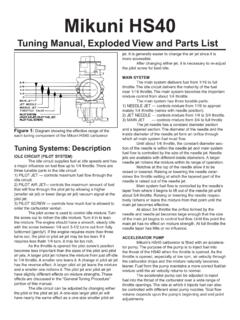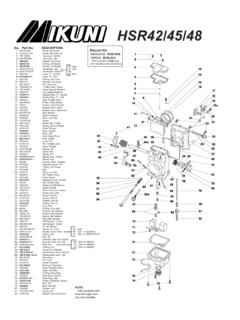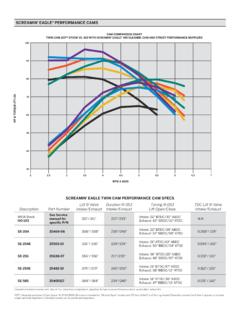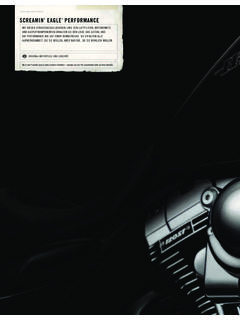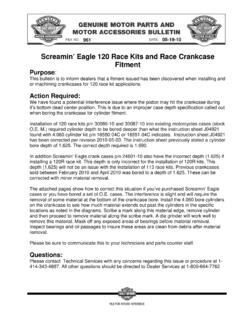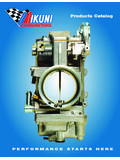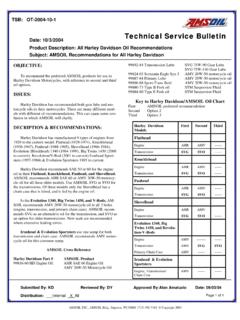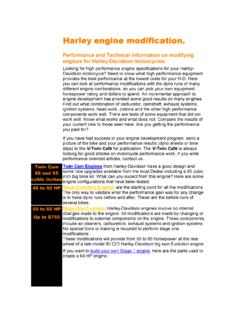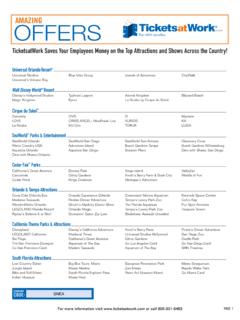Transcription of Tuning Manual 050102 - Mikuni
1 HSRT uning Manual Revised 05/01/02TM-1 Your Mikuni HSR is fitted with the Tuning parts we found to work with the great majority of engine perfor-mance modifications. However, the large number of differing after market exhaust and air cleaner systems makes it virtually impossible to accommodate all possible combina-tions with one carburetor set-up. Your HSR will almost certainly run correctly on your engine without exchanging any parts. But, if it doesn t, you may alter its Tuning to suit your engine s needs by following this exhaust system designs strongly interfere with carburetor Tuning .
2 For instance, it is very difficult to get smooth and responsive carbu-retion through the entire rpm range with open straight pipes and other unbaffled exhausts. In addition, very small volume, small diameter muf-flers are often seen by the engine as straight pipes and present similar Tuning difficulties. Very long duration cams often cause relatively poor running below 3,000 rpm, depending upon the indi-vidual cam s intake valve closing point. Such cams cause reverse air-flow out the mouth of the carburetor (often called reversion or stand-off ) that can be mistaken for a car-buretor Tuning Screamin Eagle performance parts are proven and predictable.
3 If you have any doubts about a particular exhaust system, air cleaner or ignition, you may sub-stitute the Harley Screamin Eagle parts as a reality check. When re- Tuning is required, it usu-ally involves small alterations to the idle and/or main system. The follow-ing pages supply enough information to make such alterations relatively simple. Please note that there is no point in attempting to tune any carburetor unless the engine is sound and in a good state of tune. If you have any doubts about the general condition of your engine, have it checked by your dealer or an experienced mechanic before attempting to fine-tune your LEAKS: We have found that some Har-ley-pattern engines develop minor air leaks between the manifold and heads.
4 These leaks affect air/fuel mixtures at low throttle settings and can be troublesome at idle. For best performance, it is important that you test for and eliminate any such is easy to test for intake mani-fold air leaks: With the engine warm and idling, spray WD-40 or similar paint-safe liquid around the junctions of the manifold, carb and heads. If the engine changes from its steady idle, if it surges or misses, then there is an air leak that should be the HSR42/45/48 CarburetorsTM-2TM-3 For a quick and accurate analysis, when fine- Tuning your HSR, we recom-mend using witness marks on the throttle grip and throttle housing.
5 Use masking tape on the grip and an indica-tor mark on the throttle housing. Mark the tape in 1 4 throttle increments from idle to full throttle. You can then accurately identify the throttle opening and adjust the proper Tuning : T1 HSR Tuning SYSTEMS:The HSR carburetor is divided into four interdependent systems:1. The choke system2. The idle system3. The main system4. The accelerator pump systemEach of these systems has its major effects in a different throttle range. While there may be some overlap, each system can generally be treated as though it is completely responsible for its range of throttle settings.
6 Three of the systems have replaceable components that allow fine- Tuning should the need CHOKE SYSTEM: The choke system s purpose is to provide the rich air/fuel mixture an engine needs to start and run reliably when cold. There are no replace-able Tuning parts in the HSR choke mechanism. The choke is designed to work correctly with the throttle closed. Opening the throttle greatly reduces the action of the choke. Make sure that the stock Harley-David-son choke cable is fully seated in the metal elbow at the carburetor end of the cable assembly (see Installation Instruc-tions).
7 Harley s cable is stiff and can fail to fully seat in the elbow. This condition results in poor mileage and a poor Mikuni choke cable is more flex-ible and less likely to jam. Still, it is best to check to be sure the cable is installed THE IDLE SYSTEM: (Idle 1/8 throttle) The HSR idle system has two tunable components: the Pilot Air Screw and the Pilot Jet. The air screw s purpose is to fine-tune the idle mixture. The pilot jet controls the total amount of fuel passing through the idle system.
8 The pilot jet can be exchanged for a richer or leaner one if needed (see the note on the fol-lowing page). The pilot air screw is set at two turns open from the factory. This is the position we have found to be correct most of the time. If the screw position has been altered, gently bottom it and re-open it two full turns. Next, run the engine until it reaches normal running temperature. With the engine idling smoothly, adjust the pilot air screw in slowly until the idle either slows or becomes irregular, then begin turning the screw out until the engine again slows or begins to idle :NOTE:TM-2TM-3 Count the number of turns between the two positions.
9 Set the air screw mid-way between these too-rich and too-lean positions. Use the Idle Adjuster to re-set the idle speed. If the engine becomes too hot during the adjustment procedure, the resulting idle mixture will prob-ably be on the lean side of correct. If you have a large fan, use it while adjusting the mixture. If you do not have one, you may need to take time out for a short ride to cool the engine back to normal If the best idle is achieved with the air screw less than one turn out, the pilot jet is too small and should be exchanged for a larger If the engine speed does not slow after two-and-a-half turns out, the pilot jet is too large and should be exchanged for a smaller THE MAIN SYSTEM Cam design effects When testing.
10 Consider the rpm effects of any accessory cam you may have installed. Long duration cams tend to perform poorly below some critical minimum rpm. If you attempt to test below this rpm, the engine may seem soft, flat and unresponsive. No carburetor can compensate for the engine being off the cam. All jet needle and main jet testing should be done with the engine near the middle of its rpm range, but high enough to be on the cam. All testing should be done with the engine at normal operating temperature.





